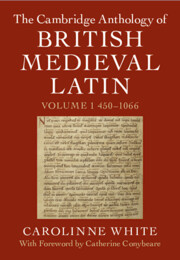Book contents
- Frontmatter
- Contents
- List of Maps
- Foreword
- Preface
- Acknowledgements
- List of Abbreviations
- Introduction
- Fifth Century
- Sixth Century
- Seventh Century
- Eighth Century
- Ninth Century
- Tenth Century
- I.33 A Layman Grants Land to His Son-in-Law, Who Sells It to the Bishop ofSelsey for Silver and a Horse
- I.34 The Monastic Agreement of the Monks and Nuns of the English Nation(Regularis concordia)
- I.35 Literary Texts Associated with St Swithun
- I.36 Æthelweard, Chronicle
- I.37 A Treaty between King Æthelred II (‘the Unready’) and Three VikingLeaders
- I.38 Ælfric of Eynsham, Preface to the First Series of CatholicHomilies
- I.39 Ælfric of Eynsham and His School, Educational Writings
- I.40 Saints’ Lives from around the Millennium
- Eleventh Century
- Select Bibliography for Volume I
- General Index
- Index of Passages Cited
I.34 - The Monastic Agreement of the Monks and Nuns of the English Nation(Regularis concordia)
from Tenth Century
Published online by Cambridge University Press: 11 January 2024
- Frontmatter
- Contents
- List of Maps
- Foreword
- Preface
- Acknowledgements
- List of Abbreviations
- Introduction
- Fifth Century
- Sixth Century
- Seventh Century
- Eighth Century
- Ninth Century
- Tenth Century
- I.33 A Layman Grants Land to His Son-in-Law, Who Sells It to the Bishop ofSelsey for Silver and a Horse
- I.34 The Monastic Agreement of the Monks and Nuns of the English Nation(Regularis concordia)
- I.35 Literary Texts Associated with St Swithun
- I.36 Æthelweard, Chronicle
- I.37 A Treaty between King Æthelred II (‘the Unready’) and Three VikingLeaders
- I.38 Ælfric of Eynsham, Preface to the First Series of CatholicHomilies
- I.39 Ælfric of Eynsham and His School, Educational Writings
- I.40 Saints’ Lives from around the Millennium
- Eleventh Century
- Select Bibliography for Volume I
- General Index
- Index of Passages Cited
Summary
The Regularis Concordia was probably written by Æthelwold of Winchester as part of the reform of Benedictine monasteries in England in the late tenth century. It is based on the Rule of St. Benedict and gives guidelines for the monastic lives of monks and nuns. It contains an early example of theatre ritual or drama. An eleventh-century manuscript of the work Cotton Tiberius A. iii contains interlinear glosses in Old English. Here the official preface tells of king Edgar’s role in the Benedictine reform.
Keywords
- Type
- Chapter
- Information
- The Cambridge Anthology of British Medieval Latin , pp. 369 - 374Publisher: Cambridge University PressPrint publication year: 2024

